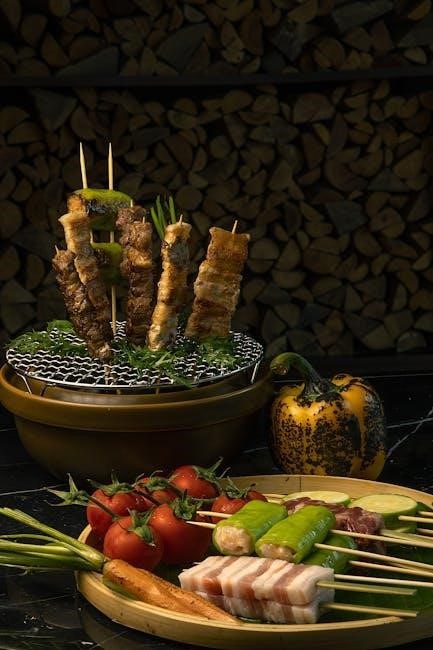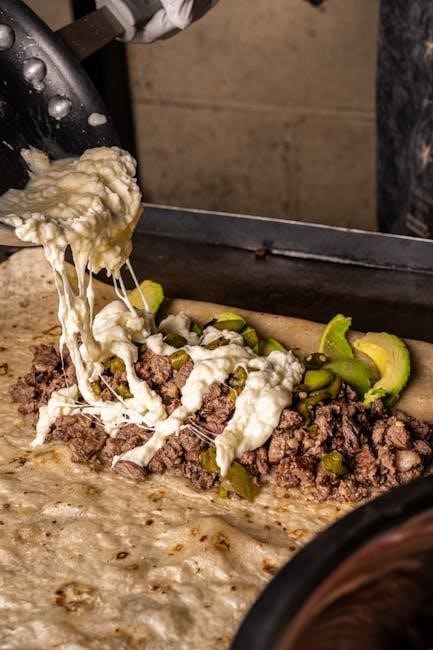Safety Precautions for Expert Grill Usage
Always ensure the grill is on a stable, flat surface to prevent tipping. Avoid overloading the grill with too much food. Regularly inspect hoses and connections for leaks. Keep a fire extinguisher or water source nearby while grilling. Never use flammable liquids to ignite the grill. Ensure all electrical components are dry before use. Properly extinguish the flame when finished grilling, using the damper to starve the fire of oxygen. Store matches or lighters out of children’s reach after use.

1.1 Essential Pre-Use Checks
Before using your Expert Grill, conduct a thorough inspection to ensure safe operation. Check the burners, hoses, and connections for any signs of damage or leaks. Ensure the grill is placed on a stable, level surface to prevent tipping. Inspect the cooking grates and heat deflectors for proper placement and cleanliness. Verify that all vents and dampers are functioning correctly for adequate airflow. Test the ignition system to ensure it lights evenly and reliably. If using gas, perform a leak test by applying soapy water to connections—bubbles indicate a leak. Clean any grease buildup in the drip tray or burners to avoid flare-ups. Always refer to the manual for specific pre-use checks tailored to your model.
1.2 Minimum Distance from Flammable Materials
Always maintain a minimum distance of 10 feet (3.05 meters) between the Expert Grill and any flammable materials, such as leaves, branches, or overhanging trees. Ensure the grill is placed away from wooden fences, deck railings, or combustible furniture. This distance helps prevent accidental fires and ensures safe grilling conditions. Additionally, avoid operating the grill within 25 feet of flammable liquids or gases. Choose a well-ventilated, open area for grilling to minimize fire hazards. Never position the grill near garages, sheds, or other structures that could catch fire. Always follow local regulations and manufacturer guidelines for specific distance requirements.
1.3 Attendance Requirements During Operation
Never operate the Expert Grill without constant adult supervision. Always stay present while the grill is in use to monitor temperature, flames, and food. Keep children and pets at a safe distance to avoid accidents. Ensure the person operating the grill is alert and not engaged in distracting activities. Proper supervision allows for quick response to potential issues like flare-ups or equipment malfunctions. Failure to maintain attendance can lead to unsafe conditions and damage. Always prioritize active monitoring to ensure a safe and successful grilling experience.
Assembly and Initial Setup of the Expert Grill
Always read the manual thoroughly before starting assembly. Use the provided tools and ensure all parts fit securely. Double-check each connection for stability. After assembly, test the grill at a low setting to ensure proper function. Retain the manual for future reference.

2.1 Tools and Materials Needed for Assembly
To assemble your Expert Grill, gather essential tools: a Phillips-head screwdriver, Allen wrench, wrench or pliers, hammer, measuring tape, and safety gloves. Have a second pair of hands ready for heavy parts. Ensure you have lubricant for moving parts and a soft cloth for cleaning surfaces. Keep packaging materials in a trash bag for easy cleanup. Double-check the manual to confirm all tools are available before starting assembly to avoid delays. Proper preparation ensures a smooth and efficient setup of your grill.
2.2 Step-by-Step Assembly Instructions
Begin by unpacking and organizing all components. Attach the legs to the grill base using the provided bolts. Next, assemble the grill body, ensuring all panels align properly. Install the cooking grates securely into the designated slots. Connect the chimney and damper, tightening all connections firmly. Attach the handle to the lid and ensure it opens smoothly. Double-check all hardware for tightness. Finally, place the grill on a level surface and ensure all parts are securely fastened. Refer to the manual for specific bolt torque values and alignment guidelines to ensure stability and safety during operation.

2.3 Initial Ignition and Testing
After assembling the grill, ensure all parts are securely tightened. Open the air vents to allow proper airflow. Light the grill according to the fuel type, following the manual’s ignition instructions. Monitor the temperature gauge to ensure it reaches the desired level. Test the grill by cooking a small item to check heat distribution. Inspect for any leaks or unusual odors during operation. Keep a fire extinguisher nearby as a precaution. Once the grill performs correctly, it is ready for regular use. Always refer to the manual for specific ignition procedures tailored to your Expert Grill model.
Choosing the Right Fuel for Your Expert Grill
Selecting the correct fuel is crucial for optimal performance and safety. Use high-quality charcoal or pellets as recommended in the manual for your Expert Grill model.
3.1 Types of Fuel Recommended
For optimal performance, use high-quality charcoal or wood pellets specifically designed for grills. Charcoal provides a classic smoky flavor and consistent heat, while pellets offer precise temperature control and efficiency. Avoid using low-quality or treated wood, as they can release harmful chemicals. Ensure the fuel is dry to maintain even burning and prevent smoke. For pellet grills, choose food-grade pellets to enhance flavor without contaminants. Always follow the manufacturer’s guidelines for the best fuel options tailored to your Expert Grill model.
3.2 Best Practices for Fuel Storage
Store charcoal and wood pellets in a cool, dry, well-ventilated area away from direct sunlight and heat sources. Use airtight containers to protect fuel from moisture and pests. Keep fuel away from living spaces and out of reach of children. Ensure the storage area is free from flammable materials. Regularly inspect stored fuel for signs of degradation or mold. Avoid storing fuel near open flames or sparks. For pellets, maintain their dryness to ensure proper burning efficiency. Proper storage prevents contamination and ensures fuel performance for optimal grilling results.
Temperature Control and Management

Monitor heat levels using the built-in temperature gauge. Adjust dampers to regulate airflow and maintain consistent temperatures. Proper ventilation ensures even cooking and prevents overheating.
4.1 Understanding Temperature Zones
Expert grills often feature distinct temperature zones, allowing for precise control over heat distribution. These zones enable you to cook different foods at varying temperatures simultaneously. Direct heat zones are ideal for searing meats, while indirect zones are better for slow cooking or keeping food warm. Use the dampers and vents to regulate airflow, balancing heat across the grill surface. Understanding these zones ensures efficient cooking and prevents overheating. Proper zone management also helps maintain consistent temperatures, crucial for achieving perfect grilling results. Always refer to your model-specific manual, such as the 720-0804D, for zone configurations tailored to your grill.
4.2 Monitoring and Adjusting Heat Levels
Monitoring and adjusting heat levels is crucial for optimal grilling performance. Use the built-in thermometer to track temperature accurately. Adjust the dampers to regulate airflow, increasing or decreasing heat as needed. For higher heat, open the vents wider; for lower heat, close them partially. Regularly check food temperatures to ensure even cooking. Avoid overheating by monitoring the grill’s heat zones. If heat levels fluctuate, adjust the fuel supply or reposition the food. Always keep a fire extinguisher nearby in case of unexpected heat spikes. Proper heat management ensures safer and more efficient grilling experiences.

Cooking Techniques for Optimal Results
Master direct and indirect grilling methods for even cooking. Preheat the grill properly, place food strategically, and adjust vents to control heat distribution. This ensures perfectly cooked meals.
5.1 Direct Grilling Methods
Direct grilling involves placing food directly over the heat source for a crispy exterior and caramelized flavor. Preheat the grill to the desired temperature, ensuring grates are clean and lightly oiled to prevent sticking. Place food like steaks, burgers, or vegetables directly over the flames. Sear for 2-3 minutes per side to lock in juices. For even cooking, rotate food 90 degrees after searing. Use a thermometer for precise internal temperatures, especially for meats. Avoid pressing down on burgers to maintain juiciness. Once cooked, remove food from the grill and let it rest before serving to retain moisture and flavor.
5.2 Indirect Grilling Techniques
Indirect grilling is ideal for cooking larger or delicate foods without direct heat exposure. Preheat the grill and turn off burners to create a cooler zone. Place food like roasts, whole chickens, or fish in this area. Use a drip pan to catch juices and promote even cooking. Close the grill lid to trap heat and ensure consistent temperature distribution. Cook at lower temperatures (300-350°F) for extended periods, checking food periodically without lifting the lid excessively. This method prevents burning and ensures tender, evenly cooked results. ideal for dishes requiring longer cooking times, such as brisket or ribs.

Maintenance and Troubleshooting
Regularly clean grates with a wire brush and oil them to prevent rust. Check for blockages in burners or vents to ensure proper gas flow. Inspect hoses for cracks or damage and replace if necessary. Store the grill in a dry, covered area during off-season. Address rust spots immediately with a wire brush and protective coating to maintain longevity.
6.1 Regular Cleaning and Care
Regular cleaning is essential to maintain your Expert Grill’s performance and longevity. After each use, brush grates with a wire brush to remove food residue and wipe them with oil to prevent rust. Clean the burner tubes and vents to ensure proper gas flow and ignition. Use mild detergents and water to wipe down exterior surfaces, avoiding abrasive cleaners that might damage finishes. Always allow the grill to cool completely before cleaning. Store the grill in a dry, covered area during off-season to protect it from moisture and debris. Regular deep cleaning every few months will help maintain its efficiency and appearance.
6.2 Common Issues and Solutions
Common issues with Expert Grills include uneven heating, grease buildup, and rust formation. For uneven heating, ensure burner tubes are clean and free of blockages. If grease accumulates, remove and clean the grease pan regularly. Rust can be prevented by drying the grill thoroughly after cleaning and applying a rust-inhibiting coating. If ignition issues occur, check for blockages in the gas lines or igniter. For stubborn stains, mix baking soda and water to create a paste, apply it to the affected area, and scrub gently before rinsing. Always refer to the manual for specific troubleshooting steps to maintain optimal performance.
By following the expert grill instructions outlined in this guide, you can ensure safe, efficient, and enjoyable grilling experiences. Proper assembly, regular maintenance, and adherence to safety precautions are key to maximizing your grill’s performance. Whether you’re a novice or an experienced griller, understanding temperature control, cooking techniques, and troubleshooting common issues will elevate your results. Always refer to your grill’s manual for specific guidance, and remember to clean and store your grill properly after each use. With these tips, your Expert Grill will provide years of delicious meals and memorable outdoor gatherings for you, your family, and friends.
